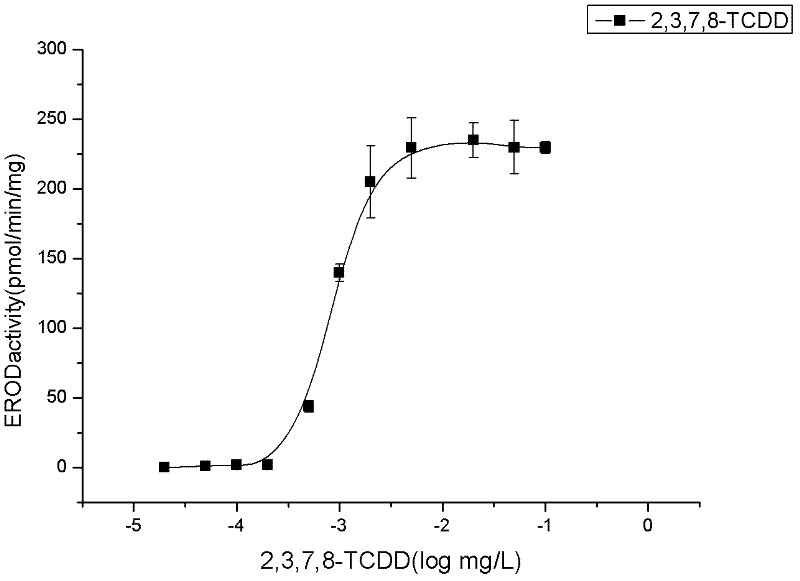Method for detecting dioxins in environment
A technology for detecting environment and dioxins, which is applied in biochemical equipment and methods, measuring devices, and microbial measurement/inspection. It can solve the problems of long detection time, high cost, and difficulty in obtaining antibodies. Wide application and low cost effect
- Summary
- Abstract
- Description
- Claims
- Application Information
AI Technical Summary
Problems solved by technology
Method used
Image
Examples
Embodiment 1
[0035] Using the rat hepatoma H4IIE cell EROD enzyme activity induction method to measure the effect of 2,3,7,8-TCDD to draw a standard curve, the method is as follows:
[0036] 1. Cryopreservation: Add 20% serum and 10% DMSO to the DMEM medium to make a cryopreservation solution, add the rat hepatoma H4IIE cell mixture into the cryopreservation tube, suck out the supernatant after centrifugation, and add the cryopreservation solution. Pipette the stored solution evenly, put it in a freezer box and place it in a -80°C refrigerator for gradient cooling for more than 3 hours, and then transfer it to a liquid nitrogen tank for storage.
[0037] 2. Resuscitation: Quickly take out the cryopreservation vial containing the frozen cells from the liquid nitrogen tank, quickly place the vial in a 37°C water bath and shake slowly until it dissolves. Immediately after dissolving, transfer to a 37°C water bath, and shake slowly by hand to keep the temperature constant for 2 minutes. After...
Embodiment 2
[0055] The sample is a soil sample collected in a special zone in the south in September 2010.
[0056] Sample collection and storage methods refer to the requirements of HT / T166-2004 and GB17378.3 respectively. About 1 kg of surface soil samples were collected from a reservoir in the south with a clean stainless steel soil picker, wrapped in tin foil and placed in a sealed bag, sent back to the laboratory in a low-temperature environment, dried and ground with a freeze dryer below -70 °C. Weigh 80 g of the soil sample that has passed through a 200-mesh sieve, and use the traditional Soxhlet extraction method to extract with toluene solvent for 48 hours. The obtained extract is rotary evaporated to 1-2 ml with a rotary evaporator, and then 100 ml of n-hexane is added to dissolve it and continue to spin. Steam to 1-2ml. Dissolve the sample to 20ml with n-hexane, take 5ml of the solution (that is, containing 20g of soil sample), purify the 5ml sample through a multi-stage silic...
PUM
 Login to View More
Login to View More Abstract
Description
Claims
Application Information
 Login to View More
Login to View More - R&D
- Intellectual Property
- Life Sciences
- Materials
- Tech Scout
- Unparalleled Data Quality
- Higher Quality Content
- 60% Fewer Hallucinations
Browse by: Latest US Patents, China's latest patents, Technical Efficacy Thesaurus, Application Domain, Technology Topic, Popular Technical Reports.
© 2025 PatSnap. All rights reserved.Legal|Privacy policy|Modern Slavery Act Transparency Statement|Sitemap|About US| Contact US: help@patsnap.com



